Chigger - The garden mite
After a good nap in the grass at the end of summer, itchy red blisters appear in certain places on your body… You are probably the victim of chigger larvae bites, small external parasites that use you as a pantry. ! Discover in this file a set of answers and products that will allow you to best fight against this insect, which is more and more present each year during the summer period.
|
I wish |
|---|
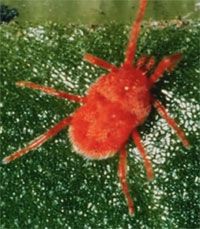
Scientific name : Trombicula autumnalis
Order : mites
Family : trombiculidae
Size adult : 2 mm
Location : garden, rather humid and shaded
Period : summer period
What you need to know about the chigger
Chiggers are part of arachnids and therefore mites (and not insects). They are also called according to the regions: trombidium, red mullet, puron, vendangeron, red spiders... This mite is cosmopolitan. They are found throughout Europe, Asia, America.
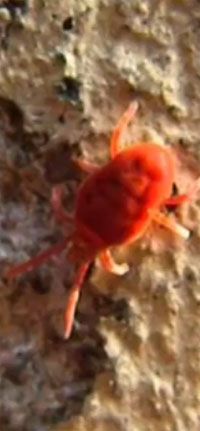
The chigger should not be confused with another mite, the silky trombidion, which is harmless to it.
The adult chigger has 4 pairs of legs (therefore 8 legs) while the larva has only 3 pairs (6 legs).
They lurk in the herbs and plants of our gardens during the summer and early fall, hoping that a mammal or a bird will pass in front of them in order to settle there to have a good meal. Like most mites, it does not feed on blood, but on tissue fluids and cells of the squamous layer previously liquefied and predigested by the enzymes that it has injected with its saliva.
Adults measure between 0.6 and 1 mm (up to 2 mm) and are yellowish-white. In the spring, females can lay up to 400 eggs in the ground. Chiggers eggs are able to re-enter, when weather conditions become severe (too cold) in a phase called diapause (resting phase). It reactivates as soon as the temperature rises. After a month, the young larvae come out in search of a host. They measure between 0.2 and 0.5 mm and are orange in color.
They bite vertebrates to feed on the lymph and tissues under their skin. For this, when the larvae manage to climb on their prey, they look for the ideal place to bite: an area of thin, moist and covered skin, such as the folds of the groin, the knees, the armpits, under the breasts or the testicles. Once positioned, chigger larvae use their chelicerae (mouthparts) and penetrate the skin. Once the hole is created, the larva will secrete saliva containing enzymes which will actually dissolve the tissues in contact. They will then be ingested with the blood and the lymph. This results in the appearance of an itchy red blister. A larva after engorgement (after a “meal”) can measure up to 1 mm (therefore visible to the naked eye).
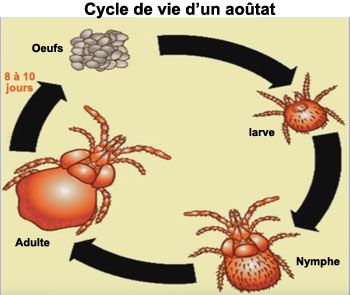
It is their saliva that causes the itching (allergic reaction), as well as the immune reaction due to the hole left by the larva. At this stage, the chiggers are red and are also called "mullets". The larvae feed in this way for 2 to 3 days, then, once sated, fall back to the ground and burrow into the ground where they will turn into a pre-pupa (immobile), a nymph (mobile) and then an adult. The complete cycle of a chigger varies between 2 and 12 months and depends a lot on weather conditions.
Their main hosts are rabbits, hedgehogs, moles, rodents, cats and dogs, birds, reptiles (and yes, even cold-blooded animals!), etc. Humans are also affected by chigger bites. Nymphs and adult chiggers are blind. Unlike the larva, they feed on plant debris, small insects, small mites, fungi.
The chigger and the temperature
The sensory perception of heat is poorly developed in the chigger, which seems, according to laboratory tests, incapable of locating a hot tube or the body of a young live mouse. In contact with a heated object, it produces a response for a temperature difference of approximately 15°C. In a linear or concentric temperature gradient, it has low and high temperature avoidance zones which seem to indicate a temperature preferendum between 15°C and 26°C.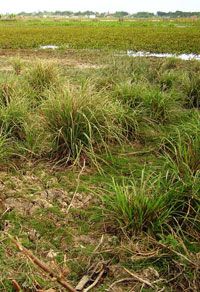
Chigger's favorite haunts
Chiggers are particularly fond of fields, tall grass, the edge of woods, shady and damp lawns, near water. They are found from March to October but more particularly when the temperatures are warm, from July to September. Periods of drought are very suitable for chiggers. Adult chiggers overwinter.
Chiggers in dogs and cats
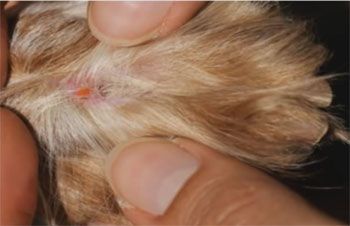
Presence of chigger larvae on a dog's paw If your cat or dog is scratching, licking abnormally or biting intensely at the end of summer and in autumn, look for the presence on its skin of small orange clusters (fluo) . It is very likely that they are chigger larvae (It's the larvae, not the adults, that infest the dog's skin!).
Chiggers like the thin skin of our animals, between the toes of the legs, on the anal and vulval folds, on the inside of the thighs, on the testicles, on the ears, around the eyes and on the belly.
The intense itching can cause your friend to severely damage his skin and secondary wounds (erosions, scabs) can then appear.
Not all dogs have an allergic reaction to the enzymes injected by the chigger larvae, in which case some dogs bitten by chigger may only have a surface lesion.
Although there is no life-threatening risk in the event of a bite, many dogs develop significant inflammatory lesions due to the intensity of the itching.
In the summer examine your animals and see if there are tiny bright orange dots, signs of the presence of chiggers.
If they are, just spray the affected areas with an anti-flea and anti-tick spray that you can get at a pharmacy or from your veterinarian.
To avoid further contamination, you can treat your animal preventively with this spray during the risk period. Spray the product between the fingers, behind the ears, between the thighs and under the armpits. Sprays should always be done before a walk or a good meal so that your pet does not lick off the medicine, which cannot be ingested.
There is no contagion between dogs and humans. However, infestation by the larvae of Augustats can also occur in humans from the same sources, such as grass.
To sum up, how do you protect your pets from chiggers ?
1 - Treat the baskets or kennels of your pets with our 4J all-insect insecticide diluted to 5% (500ml spray for 5 m²).
2 - You can protect your pets with various repellents : before going out in tall grass, protect your dog occasionally with our Stop Ticks and Fleas lotion or our Al'tO Zinsect spray insect repellent.
3 - Check their coat regularly and carefully, especially after an outdoor walk to check that no chiggers are attached to them. Avoid sleeping with your pets.
N.B.: If your dog is infested with chigger, you should visit a vet, as treatment of the inflammation caused by the bite of the larvae must be carried out in conjunction with pest control.
What does a chigger sting look like ?
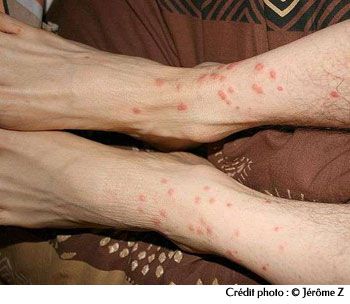
The medical term for the pathology that is given by this parasite is trombidiasis. This is an allergic reaction caused by the saliva of the larva. Unfortunately, not all of us react the same way to a chigger sting. Some people will barely react, while others will be violently itchy.
Bites of chigger larvae are usually not isolated: they are frequently aligned in a series of small pimples (papules) of 2 to 3 mm, surrounded by a lighter aureole of 1 mm, on the same part of the body. . It is also very common for several parts of the body to be affected at the same time.
Like all insect bites, the bites of chigger larvae can in some cases be complicated by the appearance of a local allergic reaction: instead of small pimples, large blistered lesions appear on the skin and the redness diffuse. The itching leaves no respite, edema may even occur. An allergy is never trivial and requires at least a visit to the pharmacist. However, if the allergy is widespread or seems severe, it is strongly advised to consult a doctor, especially if the person bitten is a young child.
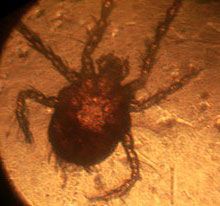
As we have already mentioned, chigger larvae often bite where the skin is thinnest (folds of the skin: behind the knees, on the wrists, inside the arms, in the groin). They also attack the most exposed and easily accessible places: the feet, ankles and legs. All areas of the skin that are slightly compressed by a rubber band or tight clothing are sources of moist heat that are perfect for chigger larvae. Children, who sometimes tend to sweat from the head, are often pricked in the scalp. Contrary to what one might think, the moment when the larva clings to the skin of its host is painless. On the other hand, during the few days that chigger larvae stay on the skin of their human or animal host, they secrete a very irritating salivary liquid.
The itching is very intense after 20 to 30 hours and can persist for 7 days.
As we saw above, in connection with the fact that itching generally appears after the chigger larvae have emerged, it seems logical that the first itches should sometimes be felt during the night. Rubbing your body against the sheets makes it easier for the larvae to crawl out. But this doesn't necessarily mean that the bites have been inflicted by nocturnal parasites! If the itching occurs in summer and you've been lying on the grass for several hours beforehand (after ruling out mosquitoes), chances are you've been bitten by the chigger larvae, not bedbugs, which are present in or near the old wood.
How to relieve chigger bites ?
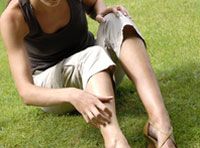
Itchy chigger bites There are effective anti-inflammatory or antihistamine creams. Alcoholic (camphor alcohol) or acidic lotions as well as solutions based on vegetable or mineral oils have a soothing action. Do not hesitate to ask your pharmacist.
Otherwise, home remedies die hard. For example, as soon as the first symptoms appear, it is advisable to take a very hot bath and soap yourself with Marseille soap. You can also soothe itching by applying a green clay poultice or a cabbage leaf to the affected areas. Ditto, a cotton soaked in a little vinegar will significantly reduce the itching associated with chigger bites.
Spike lavender essential oil will be a strong ally in relieving chigger itch. Just like a homeopathic treatment composed of granules of Rumex crispus (5 CH) or Apis mellifica (5 CH). Ask your pharmacist or your usual homeopath for advice.
Finally, our Rolls-On bites with essential oils are formulated to relieve insect bites. So remember to always have one on you during your summer outings.
Our recommendations : Be careful to limit scratching sessions! Because the more you scratch, the stronger the itching will become. So, in order not to contaminate the rest of the body, do not forget to clean your nails. You can also apply a freezer bag filled with ice cubes to the affected areas. The cold will have the double effect of calming the itching, but also of being fatal to the larvae if they are still present. The cold can burn the skin, surround the bag with a cloth or a towel.
And for your pet ? If your cat or dog is scratching because of chiggers, our soothing STOP scratch lotion based on natural plant extracts will soothe the itching for dog and cat skin hygiene.

Beware of chiggers in the grass There are several methods to protect yourself from chiggers. The most effective solution is to wear long, waterproof clothing that is well closed, particularly around the legs, to reduce access to the skin. Very nice to dress like in winter when it's hot!! If you walk in high-risk areas (tall grass, fields, edge of woods), at least remember to wear tight-fitting, covering clothing. This will already greatly limit their intrusion.
Avoid rolling around in the grass or taking a prolonged nap there. The chiggers will take advantage of these opportunities to climb on you. And if the nap call is essential, be sure to lie on a blanket, rather than on the floor.
You can also effectively protect yourself from chiggers with 3 of our products.
1 - One is to apply to your skin : Either our Anti-Insect Skin Lotion Spray or our Anti-Insect Roller. Composed of eucalyptus citriodora, these body lotions will keep most insects at bay for several hours.
2 - The other is to be applied to your textiles : our textile biting insect repellent. Composed of geraniol, this spray will deter insects from clinging to your clothes for long hours.
Some essential oils will prove powerful in protecting you from chigger bites. We can cite the essential oil of lavender, mint or eucalyptus.
Finally, a little talc spread on your skin will also make a good barrier to chiggers. Beware, however, of the drying out of the skin that this causes.
Everything you need to enjoy a sunny walk or a family picnic without the hassle of chiggers.
How to disinfect chigger bites ?
If despite the preventive measures mentioned, you have still been stung by chiggers, you will need to follow a small disinfection protocol :
1 - Put the worn clothes in the washing machine at 60°C, because larvae may still be there. For textiles that do not machine wash at 60°C, you also have the freezer solution for 48 hours. And if not, go for Aries Neem Oil Dust Mite Spray. Place your textiles in a large trash bag. Spray the aerosol inside the bag and close it tightly to make it as airtight as possible. Reopen after 48 hours.
2 - Take a hot shower or bath
3 - Rub yourself with Marseille soap to kill the parasites present on your body
4 - Disinfect the bites using an antiseptic based on hexamidine or chlorhexidine applied using a sterile compress. Repeat the operation twice a day to avoid the risk of secondary infection linked to scratching, especially in children.
How to limit the presence of chiggers ?
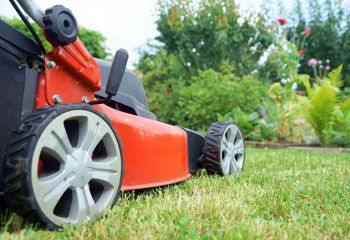 Mow the lawn to limit chiggers To avoid, or at least limit as much as possible, the development of chiggers in your garden, you can take a number of measures :
Mow the lawn to limit chiggers To avoid, or at least limit as much as possible, the development of chiggers in your garden, you can take a number of measures :
1 - Mow your lawn regularly
2 - Water the garden abundantly – chiggers do not like excess water
3 - Plant repellent plant species, such as lemon balm, lemongrass or mint.
How to eliminate chiggers ?
During the period when chiggers are present, spraying with acaricidal products can be applied to the outdoor areas concerned. However, some precautions should be taken :
1 - Start treatment at the first symptoms or a little earlier if the dates of appearance are known.
2 - Only use acaricides with low toxicity, low persistence and which respect other animals as much as possible.
3 - Only treat the portions of lawn located in shaded and humid areas and do not lie down on the treated parts for 10 days following the treatment.
4 - Treat only in non-rainy weather, after having mowed the infested parts of the lawn very close.
There is also a natural acaricide that has proven itself against the fight against chiggers : sulphur. It occurs in two forms:
- A fine powder : Sulfur flower
- Granules to be diluted in water : wettable sulfur
Our 4J insecticide to be diluted at 5% will permanently eliminate chiggers from your grassy surfaces. It is applied by spraying. As this product contains pyrethrum (which degrades rapidly under the effect of UV rays and heat), it is important to apply it during the cooler hours of the day (preferably at the end of the day). Our concentrated 4J insecticide, once diluted in water at 5% will allow you to treat up to 200 m².
Finally, diatomaceous earth, this powder composed of silicon dioxide will be formidable against chiggers. It is a natural insecticide that kills insects and slugs by dehydration by damaging their skeletons by absorbing protective waxes. You will need to spread some on the surfaces concerned and especially not to mow behind (which you will understand, will remove the powder by distributing it in the air!). This earth acts by mechanical action. Once the chigger comes into contact with this diatomaceous earth, it will eventually die from the injuries inflicted after a few days. Keep in mind that the diatom loses its drying and dehydrating properties when it is wet. Dew and rain will therefore "deactivate" its effects. Once it becomes dry again, it will resume its effects. Conclusion: keep an eye on the weather!
But beware, it is always good to remember : any chemical treatment remains detrimental to other small animals, garden helpers, and above all, to other mites which are effective predators in gardens. The best thing is to leave more room for natural predators (insects, mites, etc.) by letting the garden live a little so that they can find shelter there (heaps of dead wood, weeds, fallow land, insect nesting boxes, etc.) .). They will also make it possible to accommodate other vertebrate hosts for chiggers.
The products you need against chiggers
Step 1 - I protect my pet from chiggers just before going out
If you plan to go for a walk with your dog, don't forget to protect him from chiggers. The products below will protect it from chiggers, ticks, fleas or mosquitoes. The sprays are to be applied directly to the hair of the animal. As for the product ALT'O ZINSECT gel, it will be ideal to protect all the most sensitive parts such as the pads, the contours of the anus or sex, as well as all the places where the skin is thin and likely to interest these sucking biting insects.
Step 2 - I protect myself from chiggers
You want to garden, walk, hike or simply have a good time outdoors, so don't forget to protect yourself from chiggers in the summer. We offer several effective and natural repellents that will prevent them from biting you. The anti-insect body lotion is applied to your skin and the biting insect repellent to your textiles. As for the roll-on summer lemongrass, it will be very practical to use and easy to carry on all your trips. It will keep ticks, mosquitoes and chiggers away.
Step 3 - I eliminate chiggers from my environment
To permanently get rid of chiggers in your environment, here are the natural products we offer. First, the 4J contact insecticide. Dilute this concentrated product at 5% with water in a garden-type sprayer (950ml of water + 50ml of pure insecticide), then spread it on grassy surfaces during the cooler hours of the day ( preferably at the end of the day). Take care to mow the lawn very short beforehand to increase your chances of contact between the product and the chigger. The Aries anti-mite spray will allow you to treat your textiles or any objects (shoes, belts, etc.) after an outing exposed to chiggers. Diatomaceous earth remains a very effective product to spread on your grassy surfaces.
What about your home ? As a preventive measure, the floor of your home should be vacuumed at least twice a week to eliminate a large proportion of the chigger larvae that could potentially be disseminated.
It is also advisable to air out mattresses and pillows every morning before making your bed. A dehumidifier can be installed if the home is particularly damp.
Treating an infested area is also a priority, as it reduces the likelihood of the dog being re-infected.
This is what a moving chigger looks like
Frequently asked questions about chiggers and spider mites
Q: Is it possible to treat a specific area with your product. In what concentration do you recommend me to do it ? Will it be necessary to do it by "watering" or by spraying the supposed area ?
R: Yes, but to be really effective, it would be preferable that this area be perfectly mowed before (at least for the grass)? I think 2-3% will be enough. Watering would be more efficient, but a garden sprayer should do the trick.
Q: I'm looking for a pheromone-based trap for small spider mites, also called augustas. Does it exist ?
R: Although the red spider mite and the chigger are part of the mites and both live in the grass, there is no relationship between the 2. The red spider mite (tretranychidae family) is a parasite plants, while chigger larvae (trombidion mites) are tissue and blood suckers. Apart from that, I do not know of a trap, neither for one nor for the other !
Q: Which organic insecticide to use to treat mites (red spider mites) on a lemon tree? (ex: 4J insecticide at 1%)
R: Our products, for regulatory reasons, can only be used on houseplants (indoors and not outdoors) but in this case, you can indeed use our 4J insecticide diluted at 1.5% (ready to use).
Q: Do you have anything effective to fight against the Augustas or at least avoid getting bitten.
R: Products based on PMD (mosquito repellent) would be effective on sucking insects. Our Penntybio body lotion contains this substance.
Q: We are doing a TPE on dust mites and we would like to know which essential oils are effective against chiggers ?
R: On mites, you have essential oils such as lavender, lemongrass, mint or geranium, which have an action but mainly as a repellent.
Q: What do you recommend to fight against the proliferation of chiggers ? For the garden of course, but possibly to protect domestic animals, here dogs ? Could diatomaceous earth be effective ?
R: Every year, in very hot weather, it's the same thing. The chiggers are out and it is very difficult to escape them. For the exterior, you can treat with our 4J "small insects" insecticide concentrated at 1.5%. They are mostly found in shady, moist areas near water but you will only kill the larvae that are not buried in the ground. In terms of protection, I'm not sure that products intended for fleas and ticks are effective, diatomaceous earth is effective on all insects but its use in a garden is complicated. As soon as it gets wet its properties are no longer active.
Q: What product would you recommend for me to treat a houseplant infected with spider mites. Knowing that the ideal being to spray on the plant, isn't this harmful for it ?
R: 4 J 1.5% insecticide (small insects and mites), it is not harmful. However, the product contains soap, so if you can, a few days after treatment, shower your plant.
Q: I have an infestation of spider mites, or at least tiny (less than 1mm) little bugs that look like spider mites. They look black to me with red antennae and leave a dark green trail when crushed. The walls of my house are invaded by it (under the window sills, in the window frames, in the window rabbets, and all the way up the wall in the interstices of the plaster. I would like to know if diatomaceous earth would be effective to overcome it ??? I spent my day spraying a mixture of white vinegar + black soap + bicarbonate which seemed to eradicate them on the spot... in vain : new invasion after 10 minutes. diatomaceous earth is ineffective on mites, and if it's spider mites, then it's mites.Do you think your product can overcome this infestation ? If so how can I do to put it on all my plaster ??? Where do I start ? There's it everywhere !!! I don't even dare to open my windows anymore because I find it in the house ! How often do I put it on ? Thank you in advance for your reply, which I await impatiently.
R: Spider mites, chiggers. Considering the size and period, they are probably small insects of the mite family. Our 4J insecticide diluted to 1.5% is enough to get rid of it. It is a contact insecticide. That is to say that it will only be effective from the moment you touch them with it. This product exists either in its diluted form, ready to use, or in its concentrated form, and it is you who makes the mixture with water up to 1.5%. Like all insects, the ideal is to identify and treat outbreaks. But in practice, it remains complicated. In your case, I advise you to spray the product on the facade of your wall, insisting on the interstices of the plaster. You can also apply it to the edges and frames of your windows. The more surfaces you touch, the greater your chances of destroying as many as possible. Do the treatment during the coolest hours of the day (morning or evening) because the pyrethrum contained in the formula remains sensitive to the action of UV rays and heat. As for diatomaceous earth, if it is not very effective in outdoor use (due to the fact that it becomes inactive as soon as it gets wet), it can be a good way to fight against this type of insect. in the indoor environment. Diatomaceous earth can also be sprayed on vertical walls. For it to set properly, you will need to mix it with water in a sprayer (between 300 and 500g per liter of lukewarm water). Once projected on the walls, the water will evaporate and the diatom particles will remain attached. But once again, be careful, a heavy downpour could wipe out all the work !!




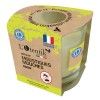
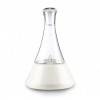

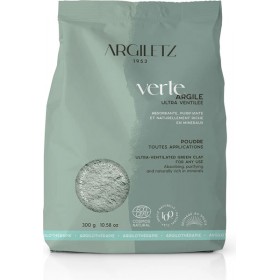
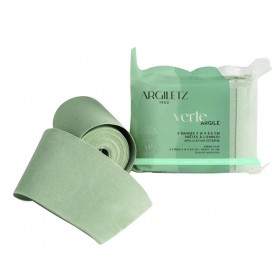
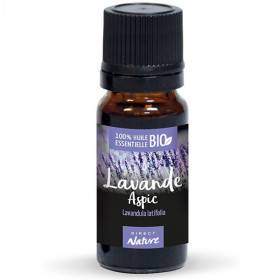
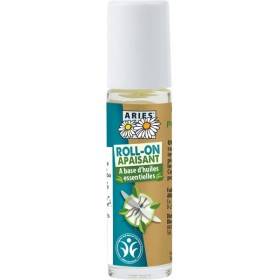
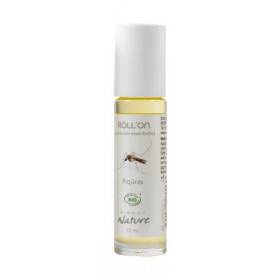
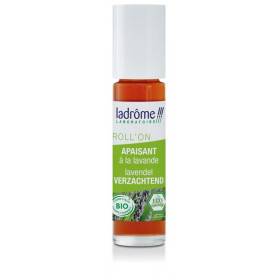
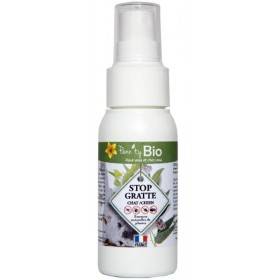
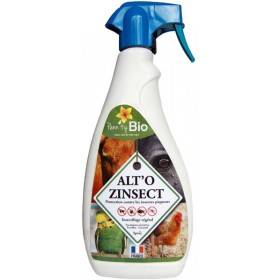
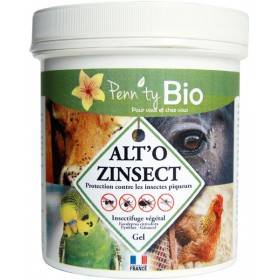
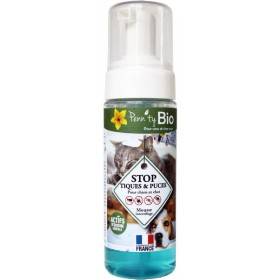
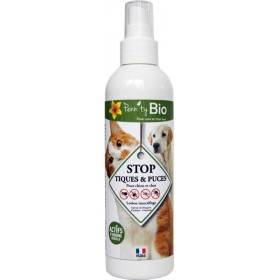
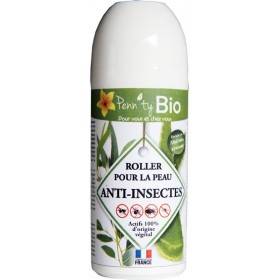
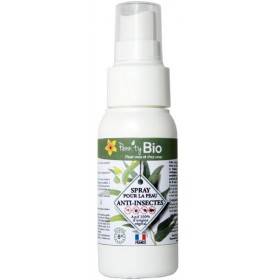
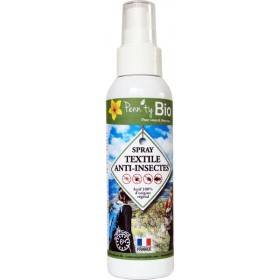

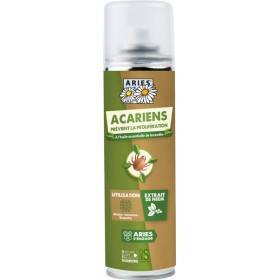
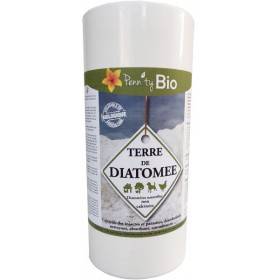
Customer reviews
Merci et surtout, continuez, c'est rare de trouver sur internet une relation aussi personnalisée sur un mode aussi agréable.
Sabine
Colis très bien protégé service rapide. Merci. Site très sérieux .
Elios R.
Marie-Noëlle
Livraison rapide et produit conforme à la description. J'approuve à 100% le principe du recyclage des éléments d'expédition. Un produit fabriqué une fois soit avoir plusieurs vie. Bravo pour cette initiative.
Christophe
La livraison est rapide, je n'ai jamais était déçue de ce site, et les produits sont pas chers et de très bonne qualité!
Patricia
Je vous remercie pour vos services. C'est très agréable d'être informé de la sorte.
Anthony
Site de produits naturels et bio très bien fait, agréable et fiable. beaucoup de produits de qualité.
Anne Marie R.
Rapide, sérieux, très bien emballé, un sans faute.Merci.
L.H.
je vous remercie pour vos services, c'est très agréable d'être informé de la sorte. colis bien reçu Merci pour la rapidité de la livraison
Bernard
J'ai reçu le colis, merci beaucoup de votre promptitude et bonne continuation.
Louise
J'ai découvert ce site en cherchant de la terre de Diatomée. Livraison rapide. Très sérieux. J'ai mis la page dans mes favoris car j'ai repéré d'autres produits.
Isa
anne-marie B.
Une entreprise fiable, efficace, de confiance, chez qui je recommande de faire ses achats.
S.
Françoise
Très bon site, du personnel sérieux et la livraison en temps et en heure. Merci
Marine T
Très bon produit facile en entretenir, pas cher.
XX
Excellent site d'achat. Très rapide et que de bons produits.
James
Livraison rapide et soignée. J'utilise les produits bio qui sont de très bonnes qualités. Un savon m'a été envoyée par erreur à la place de celui commandé et il m'a été remplacé très rapidement. Bravo pour leur réactivité. Je recommande fortement ce site.
Liliane
Contente de voir que d’autres alternatives naturelles aux produits plus nocifs soient proposés. Entreprise sérieuse dont commandes sont très bien honorées. Merci.
Capzoe
Un diffuseur plus de 80 M², avec huile essentielles eucalyptus, vraiment formidable, on respire mieux et çà sent super bon. Le matin 1 heure, et le soir 2 heures. De jolies couleur, et pour les fêtes une jolie ambiance. Bravo.
PATRICK
Merci pour le geste commercial, et aussi pour les nombreux conseils et l'excellent service client.
Tristan L
Maryse
Hélène
ANNE
livraison tip top tant en temps et en qualité.
XX
Boutique très sérieuse avec un envoie rapide et des produits super efficaces.
XX
Vos explications par email ont été très claires et votre diligence dans le traitement de ma commande et de mes demandes est très appréciée.
Henri
Noëlle G.
Toujours aussi "réactif" et efficace<br /> Bravo et merci pour votre professionnalisme.
Annick P.
Merci à Penn'ty bio d'avoir garder beaucoup de produits de la marque Lerutan et pour le sérieux dans la préparation et l'expédition des colis. Je recommande.
SR
Excellent site rapide et efficace. Descriptif intéressant.
XX
Très satisfaite. Je recommande cette société sérieuse. bon suivi de la commande.
Sandrine
Commande et livraison rapides!<br /> Rien à dire, c'est parfait !
Christine
Très satisfaite de ma commande. Emballage soigné et envoi rapide. Merci beaucoup pour votre professionnalisme !
Sophie
Efficace rapide et à l'écoute. Diversité des produits. Efficacité des produits. Respect des délais de livraison et prise en compte des spécificités client PMR ( ce n'est pas toujours le cas). Site bien fait pour navigation et produits bien mis en valeur. Des promos et des bons de réduction cumulés en fonction des achats. Merci pour votre efficacité rapidité et professionnalisme.
xxx
Juste un petit mot pour vous remercier de votre disponibilité et pour vous dire également que je suis très satisfaite des produits que j'ai acheté, ils sont vraiment efficaces.
Barb.
J'ai enfin reçu le petit colis, hier. Il a mis un mois pour me parvenir, mais vous n'y êtes absolument pour rien, comme je le pensais, il a été mis de côté lors de la grève nationale. Je vous remercie d'avoir fait faire des recherches, j'ai reçu un mot de la poste.
Hervé
Merci pour votre démarche si respectueux de l’humain, des animaux et de l’environnement !
A.F
Je parlerais de vous a mes amies car vos produits sont vraiment excellents. Bien a vous et tous mes remerciements.
Patricia
Jean Claude
Colis bien arrivé. Emballage remarquable. Diffuseur très joli, très efficace et peu bruyant avec de la couleur qui change. Très satisfaite de la commande.
Sabrina
Super, envoi rapide,bien protégé et petit cadeau !
xx
Client depuis plus de 10ans. Toujours satisfait du matériel propose. Boutique sérieuse prix compétitifs livraisons et suivis rapide.
XX
Rapidité de traitement et petit mot avec le colis très appréciable.
XX
Très bien, je recommande cette boutique
Salomé
Après un souci sur l’article livré, le site a fait preuve d’une excellente communication (simple et efficace par sms) qui m’a permis de me faire livrer un 2nd article par la marque très rapidement. Parfait !
Pierre
Commande facile, livraison impeccable et produits fiables. Merci.
Isabelle
J'ai bien reçu le colis sans aucun problème. Merci pour la rapidité et le sens du service.
Nicolas
Super !
Yann
merci pour le suivi de ma commande et les mails par lesquels vous m'avez tenu informée.
Zoé
On ne peut pas toujours faire confiance à des sites de ventes sur le web, mais sur Penn'Tio, j' y viens les yeux fermés. Excellente communication avec le service clientèle, un suivi sérieux. Je remercie chaleureusement toute l' équipe.
Sergine T.
Produits performants. Très satisfaite de vos services.
XX
Livraison très rapide et produits bien emballés.
Catherine
Totalement satisfait. Les produits sont super efficaces et tout est très bien suivis. Je recommande vivement ce site.
Stéphane N.
Bonjour Sophie & QUENTIN, Merci pour votre petit mot. . . . Ça fait chaud au Cœur de voir qu'il y a encore des Gens Comme VOUS sur cette planète ! Le monde devient de plus en FOU ! ! ! Cordialement.
Dominique T.
Excellent service et livraison rapide. A conseiller pour la santé des animaux (chiens et chats)
MICHEL
Livraison rapide et avec colis préparé avec soin :)
Florian
1ère commande. Très satisfaite : Colis expédié très rapidement et bien emballé. Merci pour votre sérieux.
Ghyslaine
Explication, commentaire et livraison en un temps record, tout était parfait, même le petit mot de remerciement écrit à la main ! Merci beaucoup
Monique S.
Un grand merci pour la qualité et la rapidité de votre réponse.
Tony
merci pour votre professionnalisme. Merci pour les produits envoyés dans de bons délais. Merci pour la qualité de vos produits
Marcelle
Rapide, sérieux et qualité, produit correspondant à la description, très contente, je recommande votre site et vos produits.
Corinne
J'apprécie les services de Penn'ty bio. Un maximum d'étoiles pour eux.
Ch. D.
Excellents produits. Excellent service.
James T
J’ai découvert cette société en faisant une recherche sur Internet pour trouver un insecticide contre les sclérodermes. Je ne peux pas encore juger l’efficacité de chacun des produits par contre je suis très satisfait de la rapidité et de la qualité d’expédition, ainsi que du sérieux de la société. J’ai même reçu un petit échantillon est un mot personnalisé j’ai trouvé ça très sympa! Merci beaucoup et bonne continuation pour votre société que je recommande déjà.
BJ79
Très contente d'avoir découvert ce site internet ! Du conseil jusqu'à l'achat c'est super. J'étais très embêtée après l'apparition de petit insecte chez nous (des anthrenes) et c'est le seule site internet e-boutique qui a pu nous renseigner dessus et enfin indiquer les produits pour les éradiquer sans pour autant nuire à notre santé (mais en respectant les conseils d'utilisation bien sûr). J'ai reçu ma commande rapidement, et avec surprise un petit mot de remerciement personnalisé avec mon nom dessus. Des détails qui au finale font la différence. Un service de qualité rien à dire. Merci !
XX
Merci d'être à l'écoute pour notre terre et vos clients. Encore une fois je suis très satisfaite de ma commande. Et mes compagnons à 4 pattes sont ravis de se protéger en bio. Merci pour votre attention manuscrite en fin du bon de commande..
Raymonde julie L.
Livraison rapide, emballage plus que parfait, le diffuseur NEOLIA est merveilleux pas bruyant, fonctionnement idéal. Merci PENNTYBIO pour votre sérieux, site web à recommander.
CLAUDE
Livré hyper vite. Bravo !
Mick
Super, livraison rapide, suivi très rigoureux, site de confiance, très sérieux à recommander... Merci pour tout.
Bernard
Commande bien reçue . Je suis très satisfaite Merci pour votre sérieux
LILIANE
Pennty Bio? Einfach genial. Super rapide , bon produits, super service-livraisons. Je vais recommander bientot =)
xxx
livraison impeccable, produit bien emballé et correspondant au descriptif, excepté pour la surface de diffusion, ma salle principale doit faire 25m2 maximum et ça ne se diffuse pas au-delà.
Pascale
Service de qualité, suivi rigoureux, et rapidité au rendez-vous. Les produits sont très fidèles à leur description et pour un coût serré. A recommander fortement.
JACKY
Service très professionnel et très rapide. A conseiller fortement.
Didier M.
Bon produit mais frais de port un peu cher.
Marie Paule
Rapidité, emballage nickel et écologique, mot de remerciements personnalisé, produits au top....j adore....je suis une nouvelle cliente conquise. Un grand merci...
Hélène P.
Comme d'habitude, envoi soigné, produits performants, Merci.
XX
Je confirme efficacité sur la préparation et expédition du matériel. un grand merci
Jeremy
Beaucoup de soins dans la commande reçue. Je recommande!
XX
Bon site, fiable, rapide et efficace.
Leo L.
Site pratique, compétent, prix corrects. Un envoi très rapide, et je dirai "parfait".
Greg
Penn' Ty Bio, c'est ma référence depuis 10 ans au moins. Je ne commande mes produits de toilette et d'entretien que chez eux. Les marques et le service est irréprochable.
GAELLE
C'est ma première commande chez Penn'Ty Bio, et ce ne sera pas la dernière.<br /> J'étais à la recherche d'un nouveau diffuseur d'HE et, après discussion avec Quentin, mon choix s'est arrêté sur l'Elixia (Direct Nature) qui est d'une efficacité redoutable et d'un silence absolument surprenant.<br /> La livraison s'est faite en 72h en point retrait avec un conditionnement hyper sécurisé.<br /> Lors du déballage, j'ai constaté un léger défaut de finition sur la verrerie.<br /> J'en ai fait part à Quentin par texto avec photos à l'appui.<br /> Il m'a aussitôt recontacté pour me proposer un envoi d'une nouvelle verrerie dès que disponible.<br /> Un professionnalisme et un sens du service exemplaires qui font de cette enseigne une valeur sûre.<br /> Penn'Ty Bio est vraiment la boutique en ligne qu'il vous faut connaître.<br /> Je vous la recommande vivement.
Jean-Yves S.
Correspond à mes attentes
Henry
Je ne connais pas encore tous les produits mais contente de ce que j'ai commandé. En revanche un peu cher quandmême ce qui me limite.
xxx
J'adore. Très grande diversité de produits, les explications sont simples et complètes.Quand aux colis, ils sont extrèmement bien protéger. Un grand merci.
Nadine
Tout va bien. Bonne année 2021.
Bernadette M.
Mon avis sur penntybio, très bon produit sur ce site pas une gamme monstrueuse mais que du très bon, et pareil pour les livraisons ultra rapides et le excellent sav si besoin. Je recommande vivement. Client depuis 2018 aucun soucis.<br /> <br />
thierry g.
Très bon site avec de très bons produits et un soin particulier apporté à la préparation de chaque commande... De plus, Sophie et Quentin prennent la peine d'écrire un petit mot de remerciement avec la commande envoyée....c'est peu commun mais très sympa....:-)
STEPHANE P.
Site sérieux, proposant de bons produits, efficaces en particulier sur les punaises de lit, fléau actuel. Merci car entre les produits et les housses de matelas nous avons réussi à les éradiquer dans deux maisons à deux ans d intervalle. <br /> Bravo aussi pour la livraison la plus écologique possible.
L.C
Site de grande qualité !
Rose Anne Marie
Livraison conforme et rapide. Les produits sont emballés dans des emballages recyclables, voire compostables : j'ai beaucoup apprécié. Je recommande ce site.
Patrick
Produits de bonne qualité, naturels et efficaces, expédition rapide et bien emballée, sav très rapide suite à une erreur de ma part,
XX
Pennty bio prends le temps de renseigner et donne de très bons conseils.<br /> Les produits sont emballés soigneusement et la préparation des commandes hyper réactive. Je recommande les yeux fermés !
Mattloumag
J'ai passé ma première commande, chez vous il y a trois jours à peine et ce matin, je reçois mon colis.
Sophie
MOI JE DIS INCROYABLE !!!<br /> Plus que mieux d'une rapidité de dingue ! bravo et le colis impeccable surprotégé.<br /> Que toutes les entreprises prennent exemple sur vous. merci
AURELIE A.
Parfait.
Philippe
Très bien , bon produits, La prochaine commande avec plaisir, livraison très rapide.<br />
Rainer
Livraison très rapide; Tout était parfaitement emballé. Je referai appel à vous.
JV39
Cliente depuis plusieurs années. Super service, réactif, cordial. Les produits sont excellents.
Christine
Sav très réactif et efficace suite à avarie durant transport. La livraison du produit en remplacement du colis défectueux à été particulièrement rapide. Merci.
Valérie
Je suis cliente depuis de nombreuses années. Toujours satisfaite du site, des produits et de la livraison.
martine O.
Très satisfaite, merci.
Christine
SATISFAITE
ANNE
Content des produits achetés, reçu rapidement et bien emballé. Merci.
XX
Je tenais à vous remercier pour votre service de qualité, une livraison toujours rapide, des colis bien emballés - qui évitent fuites et casse, ainsi que pour le petit mot personnalisé joint à chaque commande, c'est toujours très agréable.
Isabelle G
Un grand merci pour la qualité et la rapidité de votre réponse.
Simon
Suite à un précédent message notifiant une erreur de produit à la livraison, Penn'Ty bio m'a fait parvenir à titre gracieux le bon produit. Merci
Martine
Jamais déçue : les produits correspondent à la description et sont livrés rapidement.
Mireille
De très bons conseils, une livraison rapide et des produits de qualité !
Fabienne P.
très satisfaite de ma commande site vraiment sérieux livraison soignée et rapide ,les articles sont conformes a la description,je suis enchantée et recommande vivement
Marie Viviane C.
produit parfait.
René
Merci pour cette première commande, envoyée très rapidement, et dans un petit colis, avec frais de port très raisonnables.
Valérie O.
Je me permets de vous écrire un petit mot afin de vous dire que votre site est très bien fait.
Tom
Commande passée le jeudi soir, colis livré chez mon "commerçant-relais" le samedi matin. Quelle rapidité ! Du vrai professionnalisme !
Emeline
Envoi rapide. Rien a redire.
Marie France
Je voulais vous remercier +++ pour votre gentillesse et surtout... votre compétence. C'est vraiment de l'excellent travail... j'ai été bluffée :-)<br /> Renseignement téléphonique 10/5 - produit 10/5... encore merci
Maryse
Très satisfaite des délais, les produits sont bien emballés et le petit mot sympathique est fort agréable!<br />
Sylvana
Livraison ultra rapide, bien emballée. Produits au top. Parfait !
Caty
Les produits ont été très appréciés par la destinataire. <br /> De plus quand on pose une question, on a toujours une réponse, un conseil très rapidement. Merci pour votre réactivité
xxx
Très satisfaite.
Louise
Bravo ! je vous félicite pour votre efficacité et ne manquerai pas de vous conseiller.
Nicolas
Très rapide pour la livraison en Belgique et sérieux. Merci<br />
Corinne
Site sérieux. Bons produits.
Magali
Rapidité de livraison. Très bon produits. Merci
Mélina
livraison rapide, produit conforme.Prix séduisant.
XX
colis dans les temps,emballage parfait,super accueil téléphonique pour renseignement, je recommande ce site.
ROSCO
Prix intéressants. Expédition super rapide à bon prix. Et tout ça de façon agréable !
Alexis M.
Un super magasin en ligne, avec plein de produits disponibles.<br /> L'envoi a été très rapide et soigné, avec une très bonne communication à chaque étape. Bref, une adresse à connaitre et à garder ! Merci !
Pab57
Super produits accueil plus que parfait gentillesse. Livraison au top merci beaucoup
Christiane
livraison rapide, produits bien enveloppés avec juste un petit bémol : pour l'imperméabilisant dont le couvercle n'était pas bien fermé.
Alain
merci de votre disponibilité et amabilité!
Eric
Bons produits. Fonctionnent très bien.
xx
Cliente fidèle depuis plusieurs années, je ne peut que recommander ce site. Tout est parfait. Tous les produits au top, rapidité d’envoi, gentillesse, allez y les yeux fermés vous ne serez jamais déçus.
Marité 06
Merci. Je tenais à vous faire part de ma grande satisfaction. Je suis enchantée par les produits et par le service. Salutations et bonne continuation,
Odile
Merci à tanteOdile pour m’avoir fait découvrir votre site. Depuis je suis une cliente assidue. Très satisfaite de la rapidité des envois, de la qualité de vos produits qui sont par ailleurs très bien détaillés par leur composition et leur mode d’emploi. Une amie vous a rejointe également avec la même satisfaction <br /> Continuez.
Marité D.
Après la découverte des punaises de lit dans 2 chambres de notre vieille maison, j'ai trouvé votre site. le dossier m'a été très utile et je suis très contente d'avoir trouvé des produits moins toxiques que ce que proposent les autres sites de vente.<br /> Je vous remercie d'avoir répondu à mon mail car c'est un peu l'affolement quand on découvre chez soi des punaises de lit.
Françoise S.
Bonjour, je voulais vous féliciter pour la clarté de votre site, la rapidité de la livraison et la qualité de l'emballage.
catherine R.
Envoie soigné et rapide.<br /> Merci pour le petit mot à la main.<br /> Très appréciable.
XX
Vos produits sont de bonnes qualités et les produits très bien emballés
Dominique
Boutique sérieuse. Commande arrivée très rapidement. Merci pour votre gentil mot avec la facture.<br /> <br /> <br />
I Defoy
Ma commande s'est déroulée sans aucun problème avec une livraison rapide et soignée. La satisfaction est au rendez-vs ! Continuez ainsi ! Merci et cordialement !
Etoile 07
Livraison rapide et très bien emballé et protégé. Très bonne efficacité. <br /> <br />
XX
yvette
Fiable, et très bons produits , Service après vente efficace et sympathique.
Vilma V.
Très bien !
XX
Très réactifs entre la commande et la livraison. Je suis toujours satisfaite de mes commandes soigneusement emballées !
France L B
Une grande compétence, Monsieur Dufil est très professionnel et sait soigner ses clients. Quand à la gamme de produits proposés, elle est parfaite et complète.
Alain A.
Efficacité redoutable. enchanté.
Robert
Très satisfaite. Merci.
CM
Juste un petit mot pour vous remercier du message accompagnant mon colis ! Je croise les doigts pour que les produits marches mais entre-temps, je voulais vous remercier et en profiter pour vous souhaiter à mon tout un joli printemps.
Rose B.G
Jean-Yves
J'ai bien reçu ma commande. Com' dab' , rapidité efficacité ...Merci
Sally
j'ai reçu mon colis aujourd'hui, merci c'est très rapide et sérieux.
Clara
Je suis une amie de vos parents et suis toujours très satisfaite de tous vos produits. Ne changez rien et bonne continuation.
Marité D.
Je suis très satisfaite de mon échange avec le service client (personne à l'écoute, de bon conseil). Envoi rapide et soigné, avec un petit mot sympathique de l'équipe, le top!
XX
interressante. Beaucoup d'articles référencés. Après pour la lutte contre les punaises de lit, je ne suis pas sure de l'efficacité de certains produits. C'est un vrai fléau ces bestioles.
Francelyne D.
Très bien ! envoi rapide et conforme à ce qui est annoncé.
Jacqueline S.
2 commandes à mon actif et jamais déçue. Vous avez gagné une cliente régulière :) Merci pour votre sérieux et le contenu bien rempli de votre site ! c'est super d'avoir une description hyper détaillée de chaque produit.
clara
Fidèle à votre marque, je tenais par ce mail à vous féliciter vous et votre équipe pour votre longévité. Votre marque est toujours gage de qualité et sérieux.
Céline
Les produits sont de bonne qualité. Leur prix est raisonnable. Ils sont livrés rapidement, et en bon état.
XX
Bravo ! je vous félicite pour votre efficacité ne manquerai pas de vous conseiller. Merci à la prochaine commande
Anthony
très bien livraison dans les délais, colis intact, bon produit.
Martine
Bravo et merci : produits de qualité et service TOP... continuez !...
XX
Bonjour. Je souhaite vous remercier pour votre rapidité. Le colis est arrivé en bon état . Les huiles que nous avons commandées embaument la maison. Ce diffuseur est génial.
Christian
Un grand merci pour votre professionnalisme et la qualité de vos produits. Longue vie à votre site.
XX
Client depuis des années Produits de qualités et surtout qualité de service.
XX
Je tenais à vous remercier pour la commande que je viens de recevoir ce matin. Merci beaucoup et je n'hésiterai pas à recommander sur votre site.
Sandrine
J'ai bien reçu mes articles et je vous remercie pour la livraison rapide et impeccable !
Françoise
Louise
Un grand merci pour cette commande envoyée très rapidement. Je recommanderais votre site
Elise
Personne disponible, de très bon conseil suite à des punaises de lits dans mon habitation, les produits sont efficaces car depuis aucune punaises et la vie à repris son cours ... merci pour tout
Nathalie
Service clientèle très réactif en cas de difficultés. Livraison rapide. Emballage des produits fragiles excellent. Maison sérieuse, je recommande.
Marie
Très bon produit, conforme à la description.
MICHELE P.
colis reçu ce jour, merci pour le flacon offert
Andrée
Bons produits conformes à mes attentes et livraison au top. Je recommande vivement.
Chantal P.
Satisfaction totale. Entreprise au top. J'ai téléphoné le lundi matin, malgré que les contacts téléphonique ne sont que l'après midi, une personne très charmante m'a rappelé presque aussitôt pour mes donner les infos que je souhaitais connaître sur ma commande. Bravo. nous sommes mercredi et ma commande est arrivée. Encore bravo continuez comme ça.
Jacques M.
Nous sommes très satisfaits du service client : mot personnalisé dans le colis, disponibilité du service après-vente... Nous souhaitons à votre société un succès croissant.
Sara
Très contente des produits de qualités et une commande reçu très rapidement. Merci
PATRICIA A.
très bien je recommande.
Sylvie
Merci et bravo pour la qualité des produits et du service toujours aussi efficace et performant.
Annick P.
Très bons produits, service rapide et de qualité, rapport qualité/prix intéressant. Je recommande vivement.
Alain
bravo pour votre réactivité et la qualité des produits
Annick P.
Hyper cher :: très déçue du prix par rapport à la quantité de produit acheté. Sur le site internet, les flacons semblent grands, or pour 80 euros je me retrouve avec 4 flacons de petits produits insecticides... trop cher
xxx
Au fil de mes commandes (j'en suis à la 5 ou 6ème) décidément, du sérieux et de l'écoute ! chaque fois que j'ai eu un petit problème: contact immédiat, réponse immédiate, et tir rectifié illico ! Dans le top 5 de mes sites internet !
Vincent
accueil téléphonique personnalisé réactif compétent et bienveillant, livraison rapide et conforme. BRAVO merci pour la qualité de votre travail
Annick
En cette période d'avant Noël, je craignais que me colis arriverais en retard. 48h après mon achat, c'était dans la boîte aux lettres. Du coup, je suis large pour mettre mon achat sous le sapin. Merci à vous
Art4
J’ai bien reçu mon colis et vous remercie de votre rapidité. Bravo pour le geste écologique et durable. Emballage nickel ! Et mon chat a adoré jouer avec les billes jaunes !
Anouk
livraison rapide ,prix raisonnable , produits super efficace j'ai vite calmé mes douleurs lombaires ...enfin soulagée . Merci pennty bio
JEANNINE
J'ai toujours été satisfaite de mes commandes chez Penn'ty bio. Rapide efficace. Surtout les caractéristiques des produits est claire et complète. et le site contient beaucoup d'informations sur les différentes gammes. Merci pour votre travail et votre activité.
XX
Cela fait plusieurs fois que je commande chez Penn'Ty Bio et je suis toujours satisfaite de la qualité des produits et de la rapidité d'expédition. Je recommande ce site !
Ghyslaine
THIERRY
Excellente communication, service très rapide (même à l'étranger), emballage parfait ...
Jacques N., Belgique
Site intéressant. Je l'ai découvert, en fait. Produits ménager éco-responsable. Bon pour la maison et non agressifs. Merci.
Mydiadao
Livraison efficace et bon contact oral avec mon interlocutrice.
Maussane
Merci à Penn'Ty Bio pour la qualité des produits, la réactivité de l’Équipe et le petit mot attentif qui accompagne les colis. Votre site est précieux !!
Veronique B.
Toujours très bien et parfaitement emballé ! Merci<br />
Valérie
JM
Emballage au top. Livraison rapide et sans dégâts.
xxx
trés satisfaite de ma commande,( produit, et livraison,rapide ) MERCI
Danièle M.
Franchement, Penn'ty bio, c'est top ♥<br /> Quentin est super réactif, de très bons conseils. Encore merci de votre efficacité.
Hélios ☼♥
Très bon site. Navigation facile. Les commandes sont expédiées rapidement comme annoncé. Aucun problème depuis que je suis cliente. Je recommande Penn'ty bio.<br />
Elvyne
Efficace, livraison rapide.<br /> <br />
H
Commande tout à fait conforme et emballée avec grand soin.
Sarah
Je suis ravi de trouver les produits de qualité et d ‘efficacité incomparable.
Denitza K.
fidèle cliente de Penn'Ty Bio, je ne me fournis que chez eux.
XX
Très bonne adresse où l'on trouve des alternative aux produits chimiques notamment contre les insectes. Le service client est également de très bons conseils.
ck
Merci pour l'expédition de la pièce de verrerie qui a été recu cette fois sans casse. Meilleures salutations et à très bientôt sur votre site pour un prochain achat .
Louane
Livraison rapide , le tout correspond à mes attentes.
Julie
Envoi rapide, emballage au top, continuez comme ça... :-)
bruno b.
Livraison rapide , produits de qualité, je recommande Penn'Ty Bio.
XX
Commande bien reçue;je suis tout à fait satisfaite;à bientôt
Sonia
Excellent!! Commande passée le lundi, reçue le mercredi!!! Les produits sont en plus de super qualité !
MADELINE
Commande reçue rapidement, frais de port raisonnables pour expédition à l'étranger et les produits sélectionnés au top! Merci!
Cédric Adolphe B.
Très bons produits je les recommande.<br /> Merci à Pennt'ty Bio pour tout, aussi bien pour les commandes et les emballages.<br /> Bravo Pennt'ty Bio.
Bernadette G.
Bon choix, bons conseils et service livraison très rapide. J'aime faire mes courses sur ce site.
FDA
Commande reçue assez rapidement. Merci pour votre sérieux.
Émilie
comme toujours excellente réactivité, livraison très rapide et qualité produits TOP. Merci pour votre compétence.
Annick P.
J’ai bien reçu le nouveau diffuseur fonctionnel après essai et je vous remercie pour votre confiance et votre rapidité sur le traitement de mon problème. Ce n’est pas tous les jours que l’on voit un SAV aussi efficace !
Florent
Dimanche soir, invasion de vrillettes du pain. Lundi matin, commande en urgence des produits verts adéquats. Mardi, livraison, traitement et fin de l'invasion.
Jean-Pierre
Envoi rapide et soigné. Emballage ecoresponsable. Je suis ravi d’avoir trouvé des pièces de rechange pour les diffuseurs à huiles essentielles!
Ina L.
Commande reçue rapidement, très bien
XX
Site très sérieux et personnel vraiment agréable. Envoi rapide. C est parfait !
Ingrid
Tout à fait satisfait de la qualité de la livraison ainsi que du produit commandé.
Régis
Un accueil téléphonique très agréable et de très bons conseils. <br /> Merci à vous.
XX
Très bon site. Envoi rapide. Prix moins cher que sur d autres sites. Bravo et bonne continuation.
Camille
Tout est parfait : la qualité des produits, la rapidité d'expédition, la qualité du colis. Je suis enchantée et resterai fidèle à ce site.
Dominique
Toujours impeccable, les produits, les services. Depuis que j'ai changé de facteur, plus de soucis. (Ça n'est arrivé qu'une fois!!!)
XX
clair net précis. merci
jannick
Bonjour Monsieur,<br /> Nous nous étions parlés au téléphone il y a quelques années. Bravo pour l'évolution de votre site et vos dossiers instructifs. Vos produits aussi sont très bons. Bonne continuation, bien cordialement.
Marina
Site clair, envoi rapide, marchandises bien emballées, et un petit mot charmant!
SM
Sophie. A
excellent.
XX
Bons produits, emballage impeccable, livraison super rapide ! Parfait !
XX
Un grand merci pour votre offre et votre professionnalisme. Pour un service en ligne, vous savez vous rendre proche de nous. Bravo et "suerte" !
Pierre M.
Alex
Bien, la majeure partie des produits sont efficaces. Je connais cette boutique depuis plusieurs années, je recommande ce site.
XX
Site très pratique. Commande aisée. Suivi régulier. Délai de livraison respecté. Colis très soigné. Tout est parfait.
Nicole
C’est la première fois que je commande sur ce site et pas déçue livraison rapide de ce produit que l’on ne trouve pas partout. Je recommande
Patrick
Bon service et bon produits
Odile R
Tout est parfait de la commande à la réception. Commander jeudi et reçu samedi. Et très contente de mon achat . Je recommande
Nadege M.
Excellents services, très serviable
XX
Toujours satisfait et pour les prix et pour les produits.
andré a.
Impeccable.
Christine
Bonjour, j’apprécie depuis longtemps votre travail : la qualité de vos informations et des produits que vous vendez.
Frederic
Merci beaucoup pour votre rapidité et votre professionnalisme.
Julie
Très bons produits efficaces.
XX
Livraison rapide et petit mot manuscrit joint au colis, vraiment très sympa! Merci et continuez, vous le méritez.
Jean-Pierre
j'ai reçu mon colis aujourd'hui, merci c'est très rapide et sérieux.
Nathalie
C'est extrêmement délicat de votre part d'avoir fait diligence. Je ne manquerai pas de recommander votre site et de souligner votre gentillesse. Encore merci
Michel
J'ai reçu mon colis hier. Merci de vos démarches,
Sam
Client depuis de nombreuses années, je suis satisfait à la fois de la boutique et de pratiquement tous les produits achetés.
Jean-Claude
Envoi très rapide et bravo pour votre site de reconnaissance des insectes nuisibles.
Brice
Je vous remercie beaucoup de m’avoir fait profiter d’un acheminement par Colissimo alors que rien ne vous y obligeait, sauf votre conscience professionnelle, chose rare de nos jours et qu’il ne faut jamais manquer de souligner.
Cécile
Infestés de puces de parquet, le produit a agi en moins de 24 heures. Livrés en tout autant de temps. Le seul produit qui ait fonctionné et en plus archi cool pour la nature.
Nicolas
sérieux
XX
Parfait! Préparation et expédition de la commande hyper rapides. Emballage très soigné (j'ai acheté un produit fragile). <br /> Je suis très satisfaite!
Elise M.
Je suis arrivée sur votre site en cherchant un diffuseur que je viens de commander, mais je voudrais vous dire que votre site est très intéressant, bien fait. Vos dossiers sont enrichissants merci
Joelle
Colis parfaitement emballé et produits conformes. 1 des produits était très fragile et est arrivé en excellent état, merci :o) Pourquoi achetez à l'étranger alors qu'on a de si belle s entreprises en France? Tarifs identiques ou moins chers que chez Amazon ;o)
Stéphane C.
Merci pour votre geste que j’apprécie.<br /> Cela fait plaisir de retrouver l’esprit commerçant de proximité chez un vendeur en ligne. Je surveillerai attentivement cette nouvelle livraison.
Philippe
Comme toujours service "au top" réactivité, qualité produits... BRAVO et merci pour la qualité de votre travail
Annick
Parfait comme site, commandes faciles à faire et livraison rapide !
Cindy
Très contente de vos produits.
nathalie G.
Excellent site. Très à l'écoute. Livraison rapide. Problème avec un piège à guêpes un autre m'a été livré très rapidement. Chapeau et très agréable de tomber sur des gens compétents.<br /> Encore merci.
XX
Une utilisation de vos produits a suffit pour nous débarrasser des poissons d'argent. Merci.
Matthieu
Commande reçu en 2 jours, impeccable. Tous les produits emballés avec le plus grand soin, petit mot personnalisé! Et encore un petit savon bio au parfum délicieux comme cadeau!! Merci Penn'Ty Bio !!
Orchidée
Les produits achetés sur le site sont de très bonnes qualités, et j'ai été très bien conseillée. Je recommande !
Aurore
je viens de réceptionner ma commande. Tout est ok. Merci pour ces produits respectant l'environnement et l'être vivant.
Anatole
Service rapide et efficace. Et Sympathique ! toujours un petit mot, ça fait la différence. Et c'est français en plus :). Je recommande.
XX
Livraison en temps record à l'adresse indiquée en France puis départ dans l'océan indien. Reception des produits en quinze jours à l'autre bout du monde : ravie. Je vous laisserai les avis produits une fois utilisés. Le site est très bien fait et très agréable à utiliser. Le petit mot à la main dans le colis humanise la transaction, je l'ai apprécié. Je pense que vos produits sont très utiles et je vous souhaite une belle réussite et sur la durée.
Sylvie D.
Site très sérieux, de très bons produits et la livraison est rapide.<br />
Isabelle
Site internet complet, beau et facile d'utilisation<br /> Commande complète et correcte.<br /> Commande emballée a la perfection avec du matériel recyclable, compostable<br /> Délai d'envoi respecté même a l'étranger (Pays-Bas)<br /> Mention spécial pour le petit mot personnalisé ++<br /> On sait pourquoi on commande chez Penntybio depuis 10ans :)<br /> Bonne continuation
Jennifer A.
Bon produit, efficace et laisse une odeur plutôt agréable. Expédition rapide, emballé avec soins. Je recommande
Mary
Des produits très efficaces quand on suis dans l'ordre le traitement. Un léger petit bémol sur le spray insecticide, si possible essayer de trouver un spray plus puissant et plus large pour une diffusion optimale dans les coin et recoin inaccessible. Sinon tout est nickel est une excellente qualité de résultat.<br /> PS: Il faut prendre tout les produit pour un traitement efficace en foyer privé (maison).
Florian G.
Une boutique en ligne, sympa et très réactive. On apprécie surtout la livraison express. Pas besoin d'être américain pour livrer dans des délais de champion !<br /> <br />
Daniel de Paris
Livraison rapide et fiable, dès que le chèque a été reçu. Produits de bonne qualité.
Chantal H.
Site intéressant proposant de bons produits, attractifs et respectant la nature. Le regret c'est le prix de certains articles.<br />
Catherine
Je voulais juste vous remercier. J ai reçu mon répulsif " lézards" aujourd'hui, un petit mot super gentil joint à ma commande ça fait plaisir. J espère que ça va fonctionner. Bonne journée à vous et merci.
Cynthia
Parfait ! Envoi rapide et produits de qualité. Merci pour le petit mot. Je suis très satisfaite !<br />
Julieanaïs
Super efficace !!!
xx
Produit conforme aux attentes.<br /> <br /> <br /> <br />
Alain
Toujours parfait, livraison, emballage, délai et gentil petit mot personnel pour me remercier de ma fidélité.
XX
Très satisfait du site livraison rapide.<br />
Michel
Après essais de divers produits, votre insecticide 4J est le seul à être venu à bout des puces ramenées par le chat de la maison. Livraison rapide par chronopost
JEAN MARIE
J'ai été TRES bien conseillée lors du contact. Produit naturel donc c'est parfait.
Lilla
Grande gentillesse et efficacité : que demander de plus ? Merci !
Chantal M.
Marie Aline Roux
MERCI au personnel à l’emballage !!! Ma dernière commande était super bien emballée. Elle a résisté aux (épouvantables) chocs subis pendant le transport. Merci
Veronique
Après 2 traitements à 3 jours d'intervalle, j'ai réussi à éradiquer toutes les punaises de mon canapé. Produit hyper efficace que je recommande vivement.
Emmanuelle
Everything was very nice ! Keep handling your customers likes this!
xxx
Première commande chez Penn'Ty Bio : <br /> - navigation sur le site = 5/5<br /> - préparation du colis = 5/5<br /> - Prix compétitifs = 4/5<br /> - Qualité des produits sélectionnés = 5/5<br /> <br /> Vendeur à recommander.
Gaëlle
Produit de qualité conforme à mes attentes, envoi rapide et soigné, très bien.
Anne
Parfait comme d'habitude
Sylvain
Livraison très rapide. Notice livrée avec les produits ainsi qu un petit mot très agréable. Produits très efficaces, avec de l huile de coude, on en vient à bout. Le produit concentré nous a permis de tout éliminer. Par précaution, nous avons tout de même utiliser le spray. Dans une pièce, nous avons utilisé le fumigène. Pour les animaux, la mousse semble efficace. Dans quelques jours nous ferons le shampooing et plus tard les pipettes. Mais franchement après avoir utilisé d autres marques qui ne fonctionnaient pas, nous sommes ravies et nous recommandons ces produits. Merci
Virginie C.
Bonjour <br /> C'était ma première commande sur votre site et j'en suis très satisfaite <br /> Je vous remercie pour votre professionnalisme (site, prise de commande, livraison) ainsi que pour le petit mot qui rend le tout humain. Très belle journée.
CG
Bravo pour votre sérieux. Colis reçu très vite et produits impeccables. Belles fêtes de fin d'année
Mat
Pas encore essayé le produit, mais le site est très sérieux. Livraison dans un temps éclair, même si je suis en Belgique. Emballage soigné. On peut faire confiance.
Roberta
Très bon site, très sérieux je recommande, produits de qualité et service après vente au top, de plus livraison des plus rapide et produits très bien emballés, tout est parfait
virginie
Tout est parfait à chaque fois. L'attention portée va même jusqu'au petit message, c'est agréable. Fidèle aux produits et au site plus que jamais.
xx
Produits d'excellente qualité, arrivés rapidement, et conformes à leurs descriptions.
Michelle G.
j'ai bien reçu la commande et je vous remercie pour votre efficacité.
Margot
Commande bien reçue. Je suis tout à fait satisfaite. A bientôt.
Tania
Merci pour vos conseils avisés. Et merci pour vos produits de qualité.
Loïc
Merci beaucoup le colis est arrivé à la poste hier et je te retire aujourd'hui Merci pour votre efficacité et votre rapidité
Ingrid
2 commandes à mon actif et jamais déçue. Vous avez gagné une cliente régulière :) Merci pour votre sérieux et le contenu bien rempli de votre site ! c'est super d'avoir une description hyper détaillée de chaque produit.
Magali
Livraison très rapide et colis emballé soigneusement.Site à recommander.
isabelle d.
très bons produits et service commercial très performant, continuez sur cette voie, merci.
Annick
Produit anti puce extrêmement efficace !<br /> Le vendeur a pris une demi-heure de son temps pour m'expliquer absolument tout ce qu'il y avait à savoir sur le produit, de la composition a la mise en œuvre.. Bref au top ! Je recommande donc vivement Penn'ty !
Louis
Bonjour, colis bien emballé arrivé sans encombre, démarche écolo bien ancrée et petit mot perso. Merci à l'équipe de Penn'Ty Bio.
Sofi
Excellentes prestations. Les produits sont formidables, l'emballage aussi. Les délais d'expédition compétitifs. Je recommande vivement Penn'Ty Bio à tous ceux que l'état de la Planète pour les générations futures inquiètent.
XX
BIEN,CONTINUEZ COMME çà.
XX
J'apprécie depuis de nombreuses années la qualité de vos produits et le sérieux de votre site. Une petite mésaventure avec un diffuseur me permet de vous féliciter pour la réactivité de votre SAV. Bravo !
Thierry G.
Produit performant et raisonnable au niveau prix. Je recommande
XX
Un plaisir de recevoir les colis soignés et respectueux de la planète de Penn’Ty Bio. Merci
k.
Je suis vraiment très satisfaite de la prestation de ce fournisseur : délai de livraison très rapide et emballage des produits réalisé avec un maximum de soin. Bravo !!
Eliane
Félicitations pour la qualité de votre site & la valeur de ses informations ! Continuez ainsi ! On a besoin de vous !
Ronald
Livraison rapide et bien emballé. Petit message manuscrit qui fait plaisir :)
xx
Bon produits et service !
Rose-Marie
J'adore ce site qui fait un vrai travail de sélection de produits que je ne trouve pas ailleurs et sur une large gamme. Je recommande.
Veronique G.
Les produits achetés sont excellents. Ils répondent parfaitement à ce que je cherchais. Bravo pour votre site
Michel
Bon rapport qualité-prix. Envoi rapide et sécurisé !
Chrile
Excellente réactivité !!! Produit en stock, commandé le 23 dec à 8h30, recu le 24 dec à 9h30. On peut guère mieux faire ! Super communication avec le vendeur.
Xavier
J'ai bien reçu le diffuseur et j'en suis très content.
Paul
Les produits commandés sont conformes à mes attentes. Quant à l'accueil au téléphone, il est parfait et nous avons toujours trouvé un terrain d'entente. Je fais confiance à Penntybio.<br /> Merci.
XX
Dommage, les vendeurs ne savent pas lire les indications inscrites sur les produits qu'ils vendent
XX
Produits facile à utiliser, efficaces et finalement pas plus onéreux, à l'usage que des produits issus de la pétrochimie. Service livraison impeccable. Je recommande +++<br />
XX
Envoi très rapide, personnalisé et soigné. Merci
XX
Service de qualité, suivi rigoureux et rapidité au rendez-vous. Mon colis est arrivé vite même avec un paiement par chèque. Les produits sont très fidèles à leur description et pour un coût serré. A recommander fortement.
Vincent
super contente, j'y trouve facilement les produits dont j'ai besoin et le service est impeccable et gentil !
Hélène S.
Ravie de découvrir un site qui présente des produits de qualité avec une vraie démarche éco responsable à des tarifs intéressants.
XX
Bonjour Sophie et Quentin,<br /> Je viens de recevoir ma commande et je tenais à vous remercier pour la rapidité de l'envoi, votre gentil petit mot et le petit présent qui sent bon et donne envie. Bel été à vous deux également
Geneviève
Bon produit , envoi rapide.<br /> <br /> <br />
Christine
Rien à redire, de la commande à la livraison.
XX
Très bien...merci.
Olivier
Très satisfaite par Penn ty bio. En effet, suite à un produit défectueux ( housse matelas) , j'ai aussitôt reçu un bon de retour pour renvoi gratuit en colissimo et ai reçu la nouvelle housse dans les 48 h, avant même le renvoi de la première housse. Merci pour la réactivité et la confiance de cette entreprise.
dominique B.
Site très réactif livraison rapide le produit Stop tique et puce est parfait sauf le pulvérisateur.
Danielle B.
Pour ma part j'ai été satisfaite de la réalisation de ma commande et du délai de livraison. Je recommande votre société.
Nelly
Envoi rapide et soigné, produits efficaces et réponse rapide à mes questions. Je recommande.
xx
Service très réactif, emballage soigné , livraison rapide. <br /> Rien à redire . Continuez !!
Sophie
Merci pour votre envoi : rapidité, ponctualité, information de suivi du colis etc. Vraiment du bon boulot.
E.G
Livraison très rapide et produits intacts à l'arrivée grâce à un emballage impeccable.
Etta
Je viens de recevoir la pastille noire aujourd'hui et je vous remercie de votre envoi gratuit (ce qui est rare de nos jours).
Laurence
Super produits, envoi rapide et soigné, conseils et échanges courtois ! Une jolie boutique en ligne pour acheter en toute confiance ! <br />
Patricia
Commande reçu très correcte, très bon matos, encore merci et bonne continuation.
Dominique et Monique A.
L’esprit commerçant de proximité chez un vendeur en ligne !
Philippe
Livraison très rapide. Bravo pour la réactivité
François
Service au top !!!<br /> Colis reçu très rapidement avec un petit mot manuscrit me remerciant de ma commande et de la confiance que je leur ai témoigné <br /> Suffisamment rare pour être signalé <br /> Je vous encourage toutes et tous à les soutenir en passant commande chez eux!!!!<br /> Longue vie à Penn’Ty Bio !!!!<br /> Ils le méritent
Pierre-Steph
J'ai été très déçue de ne plus trouver mon déboucheur dans mon biocoop habituel, et perplexe en apprenant qu'il était remplacé par un produit à base de soude...c'est comme ça que je vous ai trouvé sur internet.<br /> Alors merci pour le dépannage, pour le mot gentil qui accompagnait mon colis , et bravo pour le calage en amidon de maïs compostable!<br /> Bravo pour votre démarche et à très bientôt.
Cécile D.
Parfait. Rien à redire. Extrêmement efficace.
Quentin
J'ai bien reçu ce jour, en bon état, les 2 diffuseurs galets. Merci aussi pour votre petit mot manuscrit me souhaitant un bel été. Fidèlement,
Annie
Livraison express. Colis toujours aussi bien préparé (cales, flocons, adhésif sur les bouchons qui risquent de couler). Bravo pour votre professionnalisme.
Isabelle
Merci pour tout le soin que vous mettez pour une livraison individualisée, chaleureuse et aussi peu impactante que possible sur l'environnement !
Sandra
Je voulais non pas faire une réclamation; mais vous féliciter pour vos produits que j' ai bien reçue, et également pour la rapidité de votre envoi ce qui est plutôt rare dans d'autre site.
Jérôme
Tout etait parfait, produit,prix,delai<br />
Marco
Produits livrés rapidement dans un colis non surdimensionné, les produits sont conformes à la description. Je recommande vivement ce site très bien fait !
Hervé
Merci pour votre sérieux et la réexpédition ultra rapide d'un achat non conforme (dont vous n'étiez pas responsable).
Marc
Parfait !
Mireille
Excellent article sur les diffuseurs d'huile essentielles ! grâce à lui j'ai pu faire mon choix basé sur une excellente analyse de votre part !
Laurence
Je vous remercie de votre professionnalisme et de votre réactivité.C'est loin d'être toujours le cas lorsque l'on commande sur internet.
Gaëlle
Merci beaucoup pour l'info, c'est rapide chez vous, très appréciable!
Denis
Avec les trois lettres BIO dans votre nom, je ne m'attendais pas à découvrir des billes de polystyrène comme matériaux de rembourrage. Il y a certainement plus écolo !
Michel D.
Modèle conforme bien emballé délai respecter continuer comme ça parfait.
Carlos
Merci beaucoup pour la rapidité avec laquelle vous m'avez fait parvenir le diffuseur.
Bichette
Quel dommage pour le produit manquant, je vous remercie pour le remboursement.
Didier
Livraison toujours rapide. J'ai expérimentée le service après vente qui à été excellent avec une réparation rapide et sans frais. Je recommande vivement Penn'Ty bio
Nadine
Très satisfaite de ma commande chez Penn'ty bio. Site très détaillé, produit reçu rapidement, message manuscrit très sympathique. Je recommande !
XM
Cliente depuis plusieurs années, j'apprécie toujours ce site. Meilleures salutations.
France
Bien reçu. Bravo pour votre extrême rapidité. Merci
Magali
Diffuseurs qui sortent vraiment de l'ordinaire, un envoi parfait - merci BCP
Anthony
Très satisfait de Penn'Ty Bio : choix étendu,prix raisonnables délais de livraison rapides.
xx
Très satisfaite du produit.Rapidité et emballage très soigné.SERIEUX.
MARLENE
Claudine
Sav rapide et disponible. Au top
Severine
C'est la deuxième fois que je commande sur ce site. J'ai découvert qu'il existait des verreries aux dimensions différentes. Mon diffuseur étant ancien, j'ai chercher le modèle le plus adapté et j'ai trouvé! Mon diffuseur fonctionne à nouveau
Christiane D.
fiable et de bonne qualité pour les services et les produits :)
XX
Juste ce petit mail pour vous dire que j'ai bien reçu votre colis et que mon patron est enchanté ! Ca embaume les huiles essentielles dans le bureau et... ça ne fait pas de bruit ! Encore un grand merci pour votre gentillesse et votre souplesse commerciale.
Sonia
rien a redire, sauf, le montant des frais de livraison, un peu élevé.
XX
service très efficace à chaque fois que j'ai commandé. aucune mauvaise surprise sur la livraison. je recommande
Agnès
Excellent service après vente après un problème d acheminement de colis par la Poste. Une relation client de très grande qualité. <br /> Cordialement,<br /> <br />
PV
Je trouve l'essentiel sur le site à des prix défiants toute concurrence. Continuez comme cela.
XX
C'est vraiment magnifique et ce cadeau a plu, je commanderais pour Noël.
Martine
Livraison rapide. Produits bien emballés.
Bruno
Merci pour votre efficacité et votre gentillesse, commande, livraison, petit mot agréable, tout était parfait !
Sylvie
Bon produit. Merci Penn'Ty Bio. Un seul passage dilué à 5% et les puces ont disparus. Il en restait deux ou trois qui ont dû se perchés pendant le traitement mais sinon c'est performant.
Axel
Service rapide et efficace. Bons produits
XX
super emballage écolo...bravo !
Isa
Produits utilisés depuis très longtemps, toujours la même qualité ! Je recommande, les délais de livraison sont très courts, produits très efficaces.
Laurence
Entièrement satisfaite.
Ch. D.
Efficacité de la livraison , très rapide . Produits livres en parfait état . Très bien emballés . Merci.
Geneviève
Parfaitement parfait, je ne me fournis que chez Penn'ty bio depuis qu'ils m'ont débarrassée de punaises de lit.<br />
MARIE CLAUDE G.
Très bon produit juste ce qu'il faut à prix attractifs Envoi rapide.
xx
Leave a review | See all